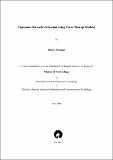Optimum network utilization using fortz-thorup method
Abstract
Internet traffic has increased over the previous years and there has been a change in traffic requirements due to the emergence of new applications and services. This makes it more challenging for the network service providers to handle congestion and provide Quality of Service guarantees. Therefore, a good management and control over the functioning of a network becomes necessary. A network service provider’s objective is then to have appropriate policies and mechanisms in place that ensures optimum functioning and utilization of the network such that the guaranteed service agreement with the users of the network is not violated.
This thesis work specifically focuses on increasing the utilization of a network by making use of existing capacity to carry more traffic. In this regard we propose a simple admission control scheme within the model of Fortz Thorup Method (FT Method), which avoids congestion while accommodating a new demand request. This admission control scheme tries to admit the new demand without requiring any reconfiguration of the OSPF weights thus speeding up the decision time to admit a new demand. It was found that when the network was operating in a state close to congestion as defined by the FT Method, many links were still operating below their existing capacities. New demands were created between pair of nodes, which were 1-hop, 2-hop, 3-hop and 4-hop apart and tests were conducted to check whether their admission caused congestion or not. We found out that as the hop distance between the node-pair increased, less and less number of admission request satisfied the admission control criteria. It was also observed that, in almost all test cases, admission requests were rejected not because their acceptance caused the congestion criteria to be violated but that there was already a link in the path followed by the new request which was violating the criteria.
Collections
- M Tech Dissertations [923]
Related items
Showing items related by title, author, creator and subject.
-
Queueing-theoretic framework for perfermance analysis of mobile ad hoc networks with finite buffer nodes
Shah, Sapan (Dhirubhai Ambani Institute of Information and Communication Technology, 2008)Wireless Ad Hoc network is a decentralized wireless network which allows nodes to join and create networks without any infrastructure. These kinds of networks are advantageous because they can be readily deployed anywhere, ... -
Wireless sensor network based automatic meter reading: WSNAMR
Sutariya, Mahesh R. (Dhirubhai Ambani Institute of Information and Communication Technology, 2009)Automatic Meter Reading is technology evolved from 1995[3] or before, for remote collection of utilities measurement data which involve Electricity, Gas and Water etc. In this process of evolution every time new idea was ... -
Comparative study between exponential back off and dynamic waiting strategies for medium access in wireless ad hoc networks
Shah, Rahul (Dhirubhai Ambani Institute of Information and Communication Technology, 2009)IEEE 802.11 DCF (IEEE 802.11 Distributed Coordination Function) is widely used MAC protocol for wireless channel access. Although it is developed for single hop networks where all nodes are in the same radio range, it can ...

